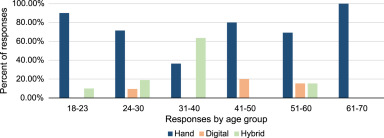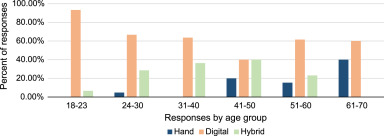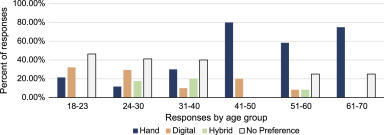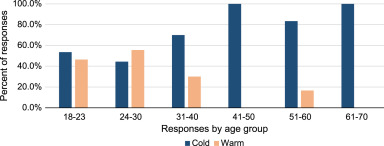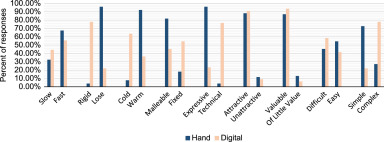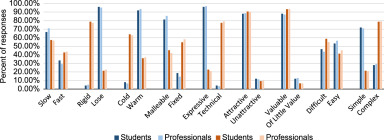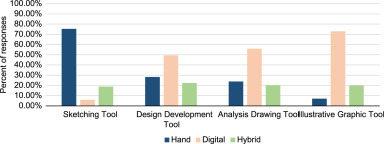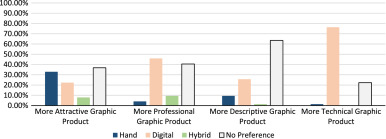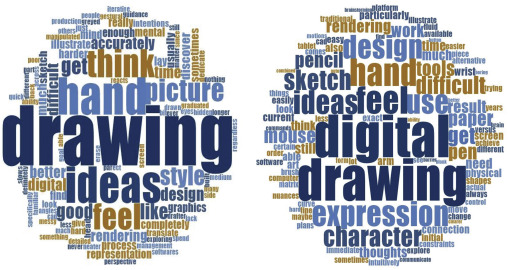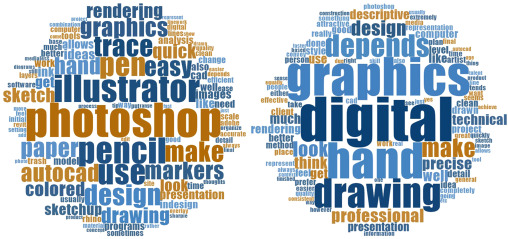Abstract
Practicing designers and design students across multiple fields were surveyed to measure preference and perception of traditional hand and digital tools to determine if common biases for an individual toolset are realized in practice. Significant results were found, primarily with age being a determinant in preference of graphic tools and processes; this finding demonstrates a hard line between generations of designers. Results show that while there are strong opinions in tools and processes, the realities of modern business practice and production gravitate towards digital methods despite a traditional tool preference in more experienced designers. While negative stigmas regarding computers remain, younger generations are more accepting of digital tools and images, which should eventually lead to a paradigm shift in design professions.
Keywords
Design tools ; Design communication ; Design technology ; Design process
1. Introduction
Design is a strongly personal process, and designers are often passionate about their tools. For centuries, design was taught and expressed through hand-drawn images and hand-built models, but the digital age has seen these norms shift toward new and unexpected directions. Computers, their processes, and the representations created through them have become highly controversial; experienced designers report that these technologies are unintuitive, cold, and lacking in character, whereas traditional hand methods are believed to foster feelings of warmth, personality, and malleability (Dorta, 2008 ; Dorta et al ., 2008 ; Lyn and Jr., 2009 ; Şenyapili and Basa, 2006 ; Tai, 2003 ).
These stigmas were established when computer technology was relatively new (at least in a Moore׳s Law timescale) and when computers were mostly considered an isolated tool in a professional office. Digital technologies have become inherent to everyday life, and recent generations grew up with computers (in multiple forms, i.e., desktops, laptops, cell phones, etc.). Entertainment created for younger generations is often digitally generated and foster a level of comfort and acceptance different from those for older age groups. Despite these societal shifts toward digital methods and products, design practice and education remain guided by experienced designers who maintain a perceived superiority of traditional hand-created methods.
Given that design firms are run by experienced practitioners, the stigmas and preferences of most people who did not grow up with digital technologies shape firm style and public perception through graphic outputs. Similar biases are manifested in design education, although students typically possess the time and freedom to explore their own production and representation styles. The questions that require answers are whether design across all professions is limited by people who are too set in their ways and if design professionals are in danger of being left behind by failing to adapt to an increasingly digital world.
This study measures opinions on design tool and process preferences to determine whether business practices (digitization of design) influence graphic content and processes without considering effect and perception. The study does not aim to discuss the superiority of either side, digital methods, or the value of the products created through these methods. Instead, this work assesses the established stigma in design professions and levels the playing field between toolsets to provide both processes an equal standing.
We hypothesize that a marked shift exists between students and professionals and between younger respondents and more experienced ones in terms of their acceptance and use of digital tools. Younger designers are expected to prefer digital methods, whereas older designers are expected to prefer traditional hand methods.
2. Literature review
2.1. Background
Computers have become extremely common that they are taken for granted in many aspects of modern life. However, many designers who frequently utilize their cell phones, smart televisions, and tablet computers have strong opinions on why digital products are inappropriate tools for design. Numerous studies have reported that computers are viable design tools (Dorta, 2008 ; Oxman, 2008 ; Şenyapili and Basa, 2006 ; Tai, 2003 ; Coyne et al ., 2002 ). Nevertheless, experienced designers continue to profess the superiority of familiar traditional methods. This argument is similar to that against older technology that we accept without question today, i.e., the tractor replacing the horse-drawn plow (Dorta, 2008 ; Coyne et al ., 2002 ). The changes in the thought process and representation that occur because of the shift toward the use of computers in design can be compared with Bauhaus’ rejection of the Beaux Arts and the adjustment in the methods and forms it inspired (Oxman, 2008 ).
The digital realm introduces designers to new terminologies, methodologies, and viewpoints. Using computers in design may lead to a change in perception but not to a change in design thought. It involves new means of seeing, interpreting, and modifying the way we view and react to reality (Coyne et al., 2002 ). Design as a process is a discussion between art and science filtered through the lens of an individual, whether that person is a designer, an observer, a participant, or an occupant (Şenyapili and Basa, 2006 ). No one tool set is inherently more artistic or more scientific than others. However, designers readily assign labels to their tools at hand, thus influencing the process and ultimate product of design and graphic representation.
Hand sketching is still the required first phase of design in many schools and offices. Hand sketches are often informal and are intended to record and refine the thoughts of individual designers. The common belief is that these sketches need to be abstract, ambiguous, and imprecise to allow a designer to maintain the “flow” and “looseness” necessary to focus within a design mode of thought. These sketches are entirely personal in nature, and their ambiguity makes them difficult to use in communicating the design intent without further explanation and illustration (Kavakli and Gero, 2001 ). Hand sketches are lacking in value when used as standalone representations of ideas for communication with other individuals or even for the designers themselves after time have separated them from their thoughts during sketching (Dorta, 2008 ; Dorta et al ., 2008 ). Such a situation is particularly true in client communication because the recipients of designed images are rarely trained in the interpretation and methods of reading graphic representations of proposed work. With design practice becoming increasingly digital (at least for the technical areas of a project) and with the ubiquity of computers and digitally produced media, whether professional bias exists against digital content and whether such perceived bias resides solely in the minds and hands of a few influential designers should be determined.
Objectively speaking, not all creative professions can create or influence the tools they wish to use in the design process. The academic and professional sectors of design professions need to continue to advocate the use of digital technologies whether for representation or fabrication, development and documentation, or administration of a project. Communication and coordination with software and hardware manufacturers are vital in expressing the needs of professional user groups (architecture, landscape architecture, interior design, graphic design, etc. as individual communities) to build tools uniquely designed for their professions (Tai, 2003 ).
2.2. Design process and ideation
The most creative designers can suspend rational thought and think abstractly. This mode is not self-sustaining because it requires regular reality checks to maintain a connection with the design in question. This dialogue between abstract and concrete domains is often recorded through sketching and physical modeling (Hanna and Barber, 2001 ; Robertson et al., 2007 ). Experience results in the ability to create large and fast creative moves while spending minimal time outside of a creative frame of mind (Dorta, 2008 ). The primary means by which designers improve their skills is by creating or analyzing other designs (Lyn and Jr., 2009 ). A highly experienced designer can create unique and inventive work faster than a novice can. This situation applies despite experienced designers experiencing similar difficulties in articulating or identifying their own design proficiencies as students do (Ibrahim and Rahimian, 2010 ).
The creativity of designers originates from abstracted thought, but this case does not necessarily apply to forms of representation and communication. Frequently, a designer assigns meaning to the lines and masses generalized in a sketch beyond what is actually visible. In response, ideation sketches are open to interpretation by others without further information. This ideation is traditionally performed with hand-drawn methods, given that digital tools have not provided an interface or toolset comfortable to most designers (Alcaide-Marzal et al ., 2013 ; Dorta, 2008 ; Hanna and Barber, 2001 ; Li et al ., 2014 ; Bilda and Demirkan, 2003 ; Coyne et al ., 2002 ; Robertson et al., 2007 ; Tai, 2003 ; Veisz et al., 2012 ). Digital tools have evolved remarkably since the majority of these studies were conducted; whether they are still applicable remains unclear. With highly advanced input tools (pens and touch screens) and continuously increasing processing speed and memory capacities, computers can work in ways people never imagined 10 years ago. If lines, forms, and objects serve as symbols defined within a designer׳s mind, then “imprecise abstraction” (as defined by Dorta) is much broader than sketching; it is a means of seeing and thinking that is independent of the toolset used for representation.
Digital tools are as capable of symbolic representation as hand sketching and can be viable tools in design ideation. With computer-based processes, the “sketch” acquires a different form and style, although the skills obtained from learning to draw with traditional tools are applicable to any graphic representation. Most university programs begin with hand drawing because it is accessible, inexpensive, and highly intuitive and familiar (Coyne et al., 2002 ).
Research suggests the existence of an on-going debate on the importance of sketching in the design process despite deeply held beliefs in the importance of sketching during ideation. Shutze (2003) discovered that designing without sketching results in weak final solutions, demonstrating the importance of visual recording as a step in refining design toward a final iteration. Other researchers (Jonson, 2005 ; Sun et al ., 2014 ; Bilda et al ., 2006 ) found that sketching is not essential in creating a strong final product when performed by experienced designers despite their adamant stance on the importance of sketching. Most designers need some semblance of visual recording, and this requirement can come in the form of precedent imagery or even spoken description of character and form. Frank Lloyd Wright designed entire projects without touching pen to paper until the time to generate the final solution for display or construction (Bilda et al., 2006 ). To these other researchers, the key component to “good” design is familiarity and experience in working with materials, forms, and situations similar to the needs of the design question at hand.
Graphic representations are utilized to record an idea for subsequent self-processing or as a communication means. When illustrating an idea for one׳s self, style and clarity can be personal and imprecise because memories and experience will fill in the gaps inherent in the graphic. An issue arises when a sketch is used to communicate with a person who is unskilled in interpreting plans or images. The style of a graphic exerts an effect on a viewer׳s perception of its content (Bakergem and Obata, 1991 ; Brown and Nahab, 1996 ), and many laypeople can see past the “pretty picture” to gather information independent of the quality of a rendered image (Tai, 2003 ; Barbarash, 2012 ). The graphics used in these studies were “finished” at differing levels of detail and well beyond the ideation stage; the results do not necessarily relate to ideation sketches, although the general concept remains applicable to using images as communication devices.
The two different uses of design imagery indicate separate means of representative thinking. Personal process sketches are not necessarily the proper tool for client communication. With professional practice typically being more concerned with end product and marketing than process and concept, style is a major component in expressing the essence of an idea (Eckert et al., 2012 ; Lyn and Jr., 2009 ; Şenyapili and Basa, 2006 ).
A direct survey showed that designers are most concerned with meeting “an internal artistic standard of excellence” (Hanna and Barber, 2001 , pg 258) and not with communicating the designed intent or function. Students express a desire for graphics to maintain some semblance of author identification through rendered character and style, which they believed are more achievable through hand drawing (Şenyapili and Basa, 2006 ). These opinions commonly confuse the roles of sketches, lumping all sketching together instead of separating those for ideation and those for client presentation. If a representation is to stand alone for itself without the designer to elaborate and explain, any level of subjectivity becomes a communication failure. Traditional sketching methods are often lauded for their “looseness,” but the appreciated ambiguity that is important to designers fails to properly express the concept and intent to paying clients and interested public (Veisz et al., 2012 ).
2.3. Previous studies on graphic tools and processes
Studies that focused on sketching obtained conflicting conclusions regarding the perception and value of the process. A large number of designers belonging to all ages and skill levels reported that they cannot design without sketching (Schütze et al ., 2003 ; Bilda et al ., 2006 ). Apparently, designers (architects in particular) are taught to value the hand sketch above all other forms of representation (Brown, 2003 ). By contrast, other studies have found that hand sketches are neither better nor worse than digital methods (Veisz et al ., 2012 ; Won, 2001 ; Bilda and Demirkan, 2003 ) and that sketching is not required to create a “good” design in any specific format (Ozkan and Dogan, 2013 ; Robertson and Radcliffe, 2009 ; Salman et al., 2014 ; Verstijnen et al., 1998 ).
In 2001, Hanna and Barber wrote that traditional drawing methods are preferred for design ideation and development despite the numerous benefits of computers (Hanna and Barber, 2001 ). In a similar study, Brown called for digital technique developers to “provide a complimentary medium that can act as a stimulating and helpful counterpart to the creation process” (Brown, 2003 , pg 708). However, this idea has not yet materialized. Most studies on digital representation tools either misused software (e.g., using CAD as a free-flowing ideation tool) or proposed an entirely new computer interface that introduces increased complexity to an already difficult process (Ibrahim and Rahimian, 2010 ; Jonson, 2005 ; Robertson and Radcliffe, 2009 ; Veisz et al., 2012 ). These programs are overcomplicated and filled with “features” that complicate simple tasks. If sketching by hand is strongly lauded and celebrated, then designers should have eased the transition toward the digital realm by simulating real freehand sketches on a computer. After generating comfort with the familiar, software programs can add levels of complexity through manipulation, layering, blending, and time-based regeneration (Dorta, 2008 ).
2.4. Limitations of tools
Previous studies and general opinions on representation and media often dealt with the absolutes and focused on the shortcomings (actual or perceived) of a tool or process. In reality, no one tool is better or worse than others because each tool has unique advantages and disadvantages that vary as a designer progresses through a design, as a project requires, and as a person gains experience with a given toolset (Tai, 2003 ; Veisz et al ., 2012 ).
While novice designers may have experienced difficulty with digital tools (Hanna and Barber, 2001 ), whether this difficulty holds true at present has not been determined. Computers are very inherent in modern life that the hand-to-digital thought process to represent an idea is easy to accept and manipulate. Other issues with novice designers, such as whether they are new to design or digital tools or whether design thought tends to be linear instead of iterative and exploratory, remain unresolved. Inexperienced designers often believe that if the computer can do a certain task, then such a task must be correct without thought to fit, art, or depth (Robertson et al., 2007 ). While this premature fixation on a single design thought is most often observed when computers are used, fixation is not solely a symptom of digital environments. Instead, it is more an issue of inexperience regardless of media use, with designers failing to question and reflect on their work.
Frequently, designers limit themselves to what is easiest to create with a digital toolset instead of exploring what is possible and best for the problem at hand (Robertson and Radcliffe, 2009 ; Tai, 2003 ). Digital tools can provide a designer false confidence in results with fast automation of complex tasks, leading to a poorly understood design, poor fit of designed elements for a given program, or designs that exhibit a similarity in form and complexity across multiple projects. Creativity is often limited by “coolness” at first glance of a computer-generated form, and this form subsequently imposes unnecessary constraints on the design (Brown, 2003 ).
Several designers generate complex models and renderings when simple representations would have sufficed to deliver a design thought (Koutamanis, 2000 ). This situation is due to an incorrect assumption by both the designer and the client that photo-realistic renderings are necessary and expected at all stages of a project. This unnecessary complexity imposes assumptions on design elements, color, materiality, etc. and can cause tension between stakeholders and designers.
The computer itself can be a barrier to creative ideation. Given the abundance of current digital packages, a designer is forced to think and work in ways that software developers (who are unlikely to be designers themselves) intend. The keyboard and mouse are often unintuitive in expressing free-flowing thought processes and can be a barrier to creative modes and innovation (Robertson et al., 2007 ; Sun et al., 2014 ). Although physical barriers exist in commonly studied digital tools, they do not influence the thinking or reasoning of designers. Experienced designers can reflect on their work and evaluate if it fits the project program (Tang et al., 2011 ). These efforts usually take advantage of hybrid methods that incorporate both traditional and digital tools to obtain a robust solution (Oxman, 2008 ).
2.5. Digital processes and issues
Digital drawing demands a different mode of creative thinking when compared with traditional forms of representation. Similar to how a sculpture is subtractive and a painting is an additive process, digital drawing can be either or both depending on the situation. This situation requires a mental malleability that must be learned and practiced. In digital drawing, familiarity with drawing lines and representing objects is digitally juxtaposed with alien interfaces and tools separate from traditional methods of creation and manipulation (Coyne et al., 2002 ). Frequently, a computer software attempts to use common phrasing and language to relate creation options to their traditional counterparts. These attempts aim to reduce the cognitive load on a designer and allow them to maintain a creative mode of thought uninterrupted by conflict and confusion with digital interfaces.
The processing of any information through a computer for those less comfortable or less familiar with digital interfaces is a form of multi-tasking. Representation of a thought is limited physically and mentally by the software and input hardware (Brown, 2003 ). This process requires novel methods in teaching the use of representation tools separate from traditional methods. Students today face additional layers of complexity during their university education compared with designers who graduated before the rise of personal computing. Students now need to learn multiple software packages to gain entry-level positions after graduation. This issue affects numerous students and higher-education programs, with many practicing designers not having any formal training in design computing (Koutamanis, 2000 ). Experienced practitioners commonly serve as partners and principals in offices and set the tone for the evolution of design professions; often, their bias against the unknown or their preference for their favored traditional tools and skillsets is forcibly impressed upon younger designers.
The act of designing can be described as thought expressed through transferrable media. This definition is an agnostic tool and allows for traditional 2D drawings, 3D models, digital drawings displayed on 2D monitors and paper, or interactive 3D virtual reality experiences. Many of those who criticize digital drawings are stuck in outdated modes of thought related to computers. They often believe that technical CAD is the only option for all aspects of design and representation.
Computer-based design consists of much more than CAD software, although most studies that criticized digital processes failed to look beyond AutoCAD-like programs created mainly for technical drafting and automated machining. The time has come for design professions to expand the definition of computer-aided design to incorporate the breadth of software and digital manufacturing options. If critics can overcome their myopic view that computers are only productivity and technical tools, then design professions could be revolutionized with new ways of conceiving, analyzing, and perceiving design (Salman et al., 2014 ). Several firms are already in this mode of thought, and they are often the innovators who win competitions and design awards.
A digital mode of thought and production can shift a designer׳s focus from a broad overall perspective to a detail-focused one. Current digital tools force decisions to be made before designers are fully ready. This situation presents advantages and disadvantages; less experienced designers become fixated and are unwilling to change a design for fear of having to throw away large amounts of work, whereas experienced designers consider experience at multiple scales up front, forcing form to follow function (Coyne et al., 2002 ).
Common criticisms on digital tools often fail to consider the computer as a tool, with the designer viewed as an entity independent of the tool in use (Koutamanis, 2000 ). Pen and paper are simply tools, except that traditional tools are often the first things taught in formal education programs. People typically have experience with them through years of self-directed writing, drawing, and experimentation. Attempting to “hand draw” using a mouse and keyboard consumes much more time and lacks character-defining elements, such as intensity and line weight variation, compared with traditional tools (Hanna and Barber, 2001 ), but this fails to account for pen input tablets that are digital analogues of their traditional counterparts.
Modern digital ideation tools simulate traditional modes of representation, but they are not solely digitized versions of hand drawings. While traditional drawing and model building are stuck in 2D or 3D modes, computers allow for a fourth dimension, time, to be included in a particular work. Digital tools can record the process and evolution of thought as a timeline for reflection, divergence, and later review. Additional layers of information can be embedded in the elements of a drawing that are hidden from regular view and thus allow a single work to be used for multiple audiences or for subsequent parametric modeling tools. Digital drawings are easily manipulated and overlaid, uncovering patterns and relationships hidden in a design. These processes are available for use in traditional methods, but the ease of editing, depth, and complexity of interaction made possible through a computer can provide a revolutionary insight into a problem while being adjustable to the needs of the moment and those of the audience (Brown, 2003 ; Coyne et al., 2002 ; Hanna and Barber, 2001 ; Robertson and Radcliffe, 2009 ; Sun et al., 2014 ).
Computer-generated images and models can serve as tools for simulation of reality and allow for the testing and analysis of a prospective design to determine optimal programmatic fit and use patterns. This changes design methodologies from a precedent-based design to a performance-based design (Hanna and Barber, 2001 ; Oxman, 2008 ). The computer has influenced more than ideation and technical drafting. It has resulted in drastic changes in communication among sub-contractors, clients, fabricators, and project management, thereby creating a more integrated and collaborative process of design unheard of before the advent of the Internet and network systems.
The concept of “flow” originally expressed by Csikszentmihalyi describes a mental state free of distraction and self-doubt where creativity and speed of production are maximized (Csikszentmihalyi, 1990 ; Csikszentmihalyi, 1997 ). Respondents in several studies described how this flow is difficult to achieve when digital tools are used and did not mention experience, familiarity, or intensity of the design problem described (Hanna and Barber, 2001 ; Coyne et al ., 2002 ). In all related research, respondents used CAD drafting software or newly created software and hardware interfaces designed specifically for the study. Notably, despite the mental break from a creative mode observed in these studies, experienced designers were able to return to their original design thought before completion of the task (Salman et al., 2014 ). This result implies that digital tools force a linearity of thought and process radically dissimilar to that of traditional methods but does not significantly affect the final product.
2.6. Experience and expertise
Digital tools affect students differently than they do professionals, and students at various stages of their education react in different ways when initiating a design. First-year undergraduate students typically worry about originality and being different, and fourth-year students (and higher) are more similar to professionals in how they work and focus. Second-year students are at an intermediary stage between these two modes of thought, and this is when many students start building their formative habits and interests (Ozkan and Dogan, 2013 ). With students appearing to favor the representational medium that they are taught in school (Robertson et al., 2007 ; Şenyapili and Basa, 2006 ; Veisz et al., 2012 ), university faculty are responsible for training students for future offices without bias and giving equal weight to traditional and digital toolsets. With the constant evolution of digital systems, students and faculty alike are signing a Faustian deal where they should never stop learning new features and formats with each successive digital update or else risk being left behind.
The students surveyed in previous studies realize the benefits of both representation methodologies as well as hybrid methods that take advantage of computers and traditional modes concurrently (Şenyapili and Basa, 2006 ). To foster this mindset of equality, courses on representation methods should not teach skills in isolation. Instead, a toolset-agnostic integrated course that focuses on communication and allows students to explore the merits and shortcomings of all available methods would be ideal (Tai, 2003 ). This course should result in highly creative work while generating graduates who are prepared for a modern professional workplace.
To create specialized tools applicable to a specific task, digital techniques transform the designer from a tool user to a tool maker. Given that students receive the majority of training with digital tools and that they have time to experiment, they, and not necessarily practitioners, must take charge of developing future technology. Graduating students can introduce new methods to offices and push design professions forward (Oxman, 2008 ; Şenyapili and Basa, 2006 ; Tai, 2003 ).
2.7. Existing stigma
A common thread in research on representation methods is the recall and celebration of the post-renaissance tools and traditions related to architectural practice and design illustration. Whether these methods are maintained because they remain the “best” means of seeing, thinking, and working should be clarified. In addition, we should analyze if we have romanticized the past by holding to the familiar while actively holding ourselves back with conservative viewpoints. In 2000, Koutamanis stated that, “Practice and criticism seem more interested in continually reinventing roles and re-establishing the order of precedence for just a few existing techniques: sketching, orthographic projection, perspective projection, and scale modeling” (Koutamanis, 2000 , pg 348). Over a decade and half later, we are still having the same discussions and are stifling innovative students and designers by forcing on them proscribed and restrictive lines of thought and methodology. This practice is despite the fact that most published critiques on representation methods are based on subjective “feeling” statements and not empirically measured response and information processing studies (Lyn and Jr., 2009 ).
Poor images and inappropriate software usages have given digital drawing methods a bad reputation (Tai, 2003 ). Studies that found CAD software to be a hindrance during design conceptualization did not use the tool for its intended purpose; a technical tool is often difficult to be considered “loose” and “abstract.” Many studies failed to account for the experience and familiarity regarding computers, despite one study finding that over 75% of survey respondents felt that digital renderings can be “generated with artistry by those who have computer proficiency” (Tai, 2003 , pg 118). Other complaints of “bland uniformity” in digital renderings are unfair characterizations brought about by inexperience with a toolset or limited training and time to explore a personal style with a given software. Uniformity with traditional tools is taught and even celebrated considering the success of rendering schools, such as Mike Lin workshops, or the similarity of the international style of architecture. This is not an excuse for lazy design thought or poor representation graphics, but as a criticism alone, uniformity and sameness are not enough to discount digital methodologies (Coyne et al., 2002 ).
Other critiques fear that specific tools, such as the ability to zoom in and out of a work, can make a designer feel lost and encourage oddly scaled elements (Lyn and Jr., 2009 ). Concern that computer rooms are lacking in creative energy compared with a traditional design studio or the unintuitive nature of drawing with a computer mouse (Hanna and Barber, 2001 ) are often used in critiquing digital education and design. These issues have all been dealt with as technology progressed or have been determined to be based on irrational fear and unfamiliarity with a toolset. Digital pen input, mobile laptops and tablets, and multi-viewport displays have addressed these concerns and rendered them moot.
The response to graphic representations regardless of the generative process has yet to be studied despite deeply held biases between “warm and emotive” hand renderings and “cold and fixed” digital images (Dorta, 2008 ; Dorta et al ., 2008 ; Lyn and Jr., 2009 ; Şenyapili and Basa, 2006 ; Tai, 2003 ). Published opinions are based entirely on personal feelings and fail to measure information delivery, understanding, or actual effectiveness. Graphics should fairly be considered works of art in their own right and should be assessed for their power to achieve their intended communicative purpose.
3. Methods
A survey was created using Qualtrics (www.qualtrics.com ) and distributed through the web after receiving the approval of the Purdue Institutional Review Board (Purdue IRB protocol # 1503015917). The survey consisted of introductory demographic questions, open response questions, and forced choice pairs comparing two sets of variables.
The demographic questions pertained to professional or student status, number of years in practice, age, and gender. The respondents were asked whether they feel a disconnection between their thoughts and their hand when using either traditional or digital tools; they were given an opportunity to describe how and why such a disconnection exists. Next, questions asking about preferred tool usage for design sketching, design development graphics, design analysis graphics, and illustrative graphics were presented. Space was provided for open-ended responses. The next set of questions asked respondents if certain methods of representation (hand or digital) create more attractive, professional, descriptive, or technical graphics. The last series of questions consisted of forced choice response sets describing hand and digital graphics independently. The choices were opposing, e.g., fast/slow, cold/warm, and malleable/fixed, and the respondents were asked to select whichever side they most agreed with, with the understanding that a few would completely agree with a choice exclusively.
A link to the survey, which includes a short description of the research focus, was posted to online message boards, such as the LinkedIn pages for the American Society of Landscape Architects (ASLA) and the American Institute of Architects (AIA) and industry-specific subreddits on Reddit.com (r/architecture, r/landscapearchitecture, r/urbandesign, r/interiordesign). The survey was also posted to different sites, such as Land8Lounge.com and ArchiNect.com. The responses were anonymous, with no tracking or identifiable data included outside of the optional demographic questions regarding age and gender.
Data were gathered and distributed as Microsoft Excel files to a set of five independent coders (undergraduate research students at Purdue University), who analyzed the open-ended responses and quantified them based on a coding guide written by the survey author. Coded sets were spot checked and analyzed for reliability (.949 intraclass correlation, α=.05). A master response matrix was built from the five individual coded sets and was then used for data analysis. Master responses were obtained from a majority coding among the five independent coders. In cases where a majority response was absent, a final designation was provided by the study author.
Data were analyzed through Pearson׳s chi-square tests. Outliers more than two standard deviations away were identified using the standard residual in SPSS software.
4. Results
A total of 151 respondents were recruited during the survey. Eighty-five of them fully completed the qualitative section of the questionnaire, and 77 fully completed the forced choice section. Among the 128 individuals who opted to identify their gender, 84 were male and 44 were female. Professional status was evenly split, with 64 student and 70 practitioner responses. The survey received an even distribution of responses within the practitioner group, whereas the student group indicated that freshmen were slightly under-represented; however, the under-representation was not significant enough to disqualify the group.
The results showed a correlation between demographic groups and method of choice or perception of graphic quality. Age was a factor in preference of tool use (hand, digital, or a hand/digital hybrid approach) in the creation of design sketches (Χ2 (10)=25.411, p=.005) and for illustrative graphics (Χ2 (10)=23.217, p=.010), with “older” respondents preferring hand methods and graphics. Age also was a determinant in opinions on which method creates a more attractive graphic (Χ2 (15)=25.654, p=.042) and whether digital graphics feel warm or cold (Χ2 (5)=11.421, p=.044). A significant gender variation was observed in the respondents’ sense of disconnection between their thoughts and hands when using digital tools (Χ2 (1)=3.908, p=.048), with men more likely to experience issues translating thought to computer-based systems than women.
A difference between students and practicing professionals was observed with regard to the tools they prefer in creating illustrative graphics (Χ2 (2)=14.251, p=.001) and in their opinions on which methodology generates a more attractive graphic (hand, digital, hybrid, or no preference; Χ2 (3)=9.157, p=.027). Student class year influenced the production methodology for analysis graphics (X2 (10)=25.906, p=.004) and perception of the attractiveness or unattractiveness of hand-drawn graphics (X2 (5)=13.260, p=.021).
5. Discussion
5.1. Quantitative results
Interestingly, despite the significant difference in numerous categories, not all displayed a single outlier that dramatically emerged from the sample set. Instead, the responses demonstrated trends or abrupt shifts in perception or choice as the demographics changed. These results demonstrate the existence of a measurable “break” in preference based on experience, training, age, and/or gender.
Age was a determinant in the choice of methodology regarding the creation of design ideation sketches (Χ2 (10)=25.411, p=.005, Fig. 1 ) and final illustrative graphics (Χ2 (10)=23.217, p=.010, Fig. 2 ). As expected, older age groups (51–60 and 61–70 years old) were evenly spread in terms of preference in using hand, digital, and hybrid methods to produce illustrative graphics, although the majority of the respondents notably selected digital tools. Younger respondents favored digital processes. Students preferred purely digital methodologies, whereas early practitioners (24–30 and 31–40 years old) have begun to incorporate hybrid techniques.
|
|
|
Fig. 1. Tool preferences of different age groups in creating design ideation sketches. |
|
|
|
Fig. 2. Tool preferences of different age groups in creating illustrative graphics. |
The response groups demonstrated a remarkable anomaly in sketching methods. Respondents aged 31–40 years preferred hybrid methods for ideation over other methods of creation. All other age groups preferred hand sketches. Younger respondents preferred hybrid or digital methods. However, as age increased, hand sketching received an increasing share of responses until it became the only accepted method.
Similar trends were observed in the perception of which methodology creates more attractive graphics (Χ2 (10)=25.654, p=.042, Fig. 3 ). Students provided split responses between hand and digital methods, with the majority preferring computer-generated images. Young practitioners (24–30 years old) tended to appreciate digital and hybrid methods, with very few selecting hand-only renderings. As age increased (31–40 and above), the respondents reported increased hand preferences, eventually excluding digital and hybrid methods altogether. This trend was also observed in the respondents’ choices of whether digitally created images felt “warm” or “cold,” with the perception shifting between the 24–30 and 31–40 age groups (Χ2 (10)=11.421, p=.044, Fig. 4 ). In this case, younger designers were relatively split between opinions on computer graphics, whereas respondents older than 31 years old overwhelmingly felt that digital images were “cold.”
|
|
|
Fig. 3. Tool preferences of different age groups for creating attractive graphics. |
|
|
|
Fig. 4. Opinions of different age groups on digital graphics feeling either “warm” or “cold”. |
The shift between the 24–30 and 31–40 age groups could benefit from some finer resolution to see where specifically the “warm” to “cold” transition occurs. The data in this study show that students who graduated before the advent of computers became ubiquitous in design education (roughly around the latter half of the 2000׳s) are less willing to accept graphics produced by digital tools, possibly indicating a perception bias based on personal experience instead of viewing an image objectively.
Men were also more prone to sensing a disconnection between their thoughts and method of production when using digital tools than women (Χ2 (1)=3.908, p =.048). With the majority of survey respondents and a disproportionate number of professional designers (specifically design project managers and firm principals) being male, this finding can explain the preference of several firms for a traditional stylistic identity (ASLA, 2012 ; NCARB, 2015 ). This finding could be due to the age discrepancies between male and female respondents. Most of the older survey participants were male, and age was found to be a determinant of preference for traditional methods.
A noticeable difference was observed between students and practicing professionals regarding stylistic preference. Students were overwhelmingly in favor of only digital methods in producing illustrative graphics, whereas professionals were interested in hybrid methods combining hand and digital techniques (Χ2 (2)=14.251, p=.001). Students were also equal in choices of which tools create more attractive graphics and were split between hand and digital production; meanwhile, most professionals preferred hand-drawn images (Χ2 (3)=9.157, p=.027).
The responses indicated differences in preference and opinion as students matriculate through their college years. Freshmen and sophomores were strongly in favor of traditional hand methods of producing graphics. This trend begins to shift in junior year, with a clear preference for digital and hybrid methods in senior and fifth year students. Seniors were more prone to perceiving hand graphics as “unattractive.” No measurable difference was determined among graduate student respondents or between undergraduate and graduate program participants. These trends appear to follow educational processes, given that early years in a design program typically begin with coursework in traditional drawing and sketching followed by computer graphics and then by highly technical courses in documentation. Students prefer hand graphics early in their studies because of existing familiarity and because they are taught and reinforced by the faculty (who tend to be older). Whether more advanced students select digital graphics because they honestly prefer them or because the industry demands it should be confirmed.
These differences in preference exert a distinct effect on the progression of a firm and its methods. Typically, entry-level hires bring new and exciting technologies and production methods to established design firms, but this scenario demonstrates a top–down outlook that limits the acceptance and integration of modern tools into project practices. A design firm cannot afford to change its style and methods with every new hire, but firm management with outdated biases against technology is probably restricting improvements in production efficiency, presentation interactivity and effectiveness, and firm identity. Thus, young designers could incorporate more traditional styles and means of production to remain grounded and to have a backup methodology when digital processes are unavailable or impractical.
The areas that showed no significant differences are also interesting. No preference was observed in appearance or methodology in creating or viewing analysis or design development drawings. Such a result is possibly due to these drawings being intended for internal communication among those who are already familiar with the particulars of a project or due to the lack of stylistic importance in comparison with design ideation and marketing graphics.
No significant disagreement was observed regarding the method that creates a more professional, technical, or descriptive graphic. The respondents believed that digital graphics are professional looking, just slightly less than those with no preferred methodology. Designers overwhelmingly prefer digital methods for technical graphics and have no preference at all for which method creates a more descriptive image.
Forced choice responses followed the expected trends (Fig. 5 ), but a more nuanced patter emerged when the responses of students were compared against those of practicing professionals (Fig. 6 ). Students are more accepting than professionals in all categories, and in several cases, they prefer digital styles and methods of information delivery. Students are likely to say that digital graphics are fast, although hand graphics are ranked as faster. Professionals were faster at both hand and digital graphics than students. Despite traditional perceptions, students with their high acceptance of computers found digital tools nearly equally “fixed” or “malleable,” whereas professionals remained close to the status quo of malleable hand graphics and fixed digital graphics.
|
|
|
Fig. 5. Forced choice responses: hand vs. digital (all responses). |
|
|
|
Fig. 6. Forced choice responses broken down into students and professionals. |
A steady transition from hand to digital methodology was observed as respondents moved along a project timeline (Fig. 7 ). Interestingly, hybrid methodologies maintained an even response rate in all phases of design. The use of a hybrid process started with purely younger respondents in the sketching phase then progressed to the older groups as a project approached illustrative graphics. This finding mirrors the observation in age preference data that highly experienced designers prefer hand methods early in the design process. The integration of hybrid methods in design development, analysis, and illustrative graphics allows for a traditional hand touch to be included in graphics that are often expected to be very polished, possibly allowing older designers to remain within their comfort zone with familiar tools. In later stages, younger designers shifted to a purely digital mode, with the remaining hand-only respondents in the 41–50 or older range.
|
|
|
Fig. 7. Tool preference in the different stages of the design process. |
Similar trends were noted in the designers’ perception of the use and appearance of graphics. Digitally created drawings dominated in creating a highly technical looking graphic, and digital technique was the highest rated method (next to “no preference”) for creating “professional” graphics (Fig. 8 ). Digital drawings were more than twice as often rated as more “descriptive” than hand drawings. While this study should have included a measure on “expressive” graphics, this finding is against the common wisdom that digital drawings contain little character and are overly sterile and that drawings with these qualities would incur difficulty in demonstrating “intent” or “emotion.”
|
|
|
Fig. 8. Preferences for image use and delivery. |
When broken down by age, respondents who felt that hand drawings are more “attractive” were evenly spread among age ranges, but those preferring digital drawings were all less than 31 years old. Younger respondents also displayed an absence of preference in the drawing process and believed that any methodology can create an “attractive” graphic.
5.2. Qualitative results
Respondents with the strongest preferences preferred traditional hand sketching for design ideation and illustrative presentation graphics. This result counters the quantitative results, which demonstrate that tool choice is not important in the sketching ideation phase of a project in relation to the finished product. The respondents who favored traditional methods were mostly older, which could lead to a paradigm shift as firm principals retire and younger designers take their places. The data do not indicate that hand methods will disappear. Instead, data suggest that they will be joined by the digital method as an equally important method in all stages of the design process.
Preferences became increasingly digital across all age and gender groups when describing a product, but respondents revealed their biases when describing the process and perceived reception of a graphic. This dichotomy shows that business practices are moving in a direction different from that of the preferences of highly experienced designers. This dichotomy poses serious implications on the day-to-day practice of a design firm. If a firm principal does not see value in the style of graphics produced by junior designers, then the firm is not taking advantage of these employees’ strongest skill set. Cases were mentioned where younger designers felt that they could not “defend” their styles or preferred methods of working and were instead forced into processes with which they were less comfortable and less productive.
Younger designers were more inclined to report that they felt a disconnection between their thoughts and their hands when sketching with a traditional pencil or pen than older designers. The majority of the respondents in this age group described their frustration with the quality of their final product or in expressing their ideas clearly. While these attitudes could be improved through practice and training, the same respondents typically did not feel a similar disconnection when working on a computer.
A word cloud analysis was conducted on the respondents’ open-ended answers. The results showed that the words utilized to describe the use of traditional tools focused largely on tool choice and personal processes. Digital tools had a more evenly distributed discussion in the design process and emotive terms (Fig. 9 ). This finding shows that proponents of traditional processes focus inwardly and feel a need to defend their specific toolset, whereas those who accept digital methods focus more on external factors relating to the design problem and audience image.
|
|
|
Fig. 9. Brain–hand disconnection word cloud for traditional (left) and digital (right) tools. |
Many respondents across all age groups felt a disconnection when using digital tools. Several respondents perceived the digital interface as being an impediment to rapid seamless ideation, but the majority related it to the “feel” of the computer and how people felt that they could not obtain the proper “character” or “expression” out of a tool. Interestingly, many of these comments directly mentioned CAD drafting software as the primary target of their disconnection and dissatisfaction. Whether these opinions would change if the respondents were given the proper tools and training appropriate for their design task should be studied, given that CAD software is rarely the ideal choice for design ideation.
Remarkable differences in responses were observed between the “which tool do you prefer” and “do you feel as if a certain method” question sets (Fig. 10 ). While the questions themselves account for some of the specific language because the survey used software terms versus emotive terms, the additional narrative responses illustrated several trends that are not distinguishable in the quantified data.
|
|
|
Fig. 10. Word clouds of tool use (left) vs. feeling (right) question sets. |
The tool use responses focused on the speed and perception of reception by a client. The feeling questions were personal and described individual experiences that explained the respondents’ preferences. These responses indicated that design professions have changed to a digital mode despite the will and preference of many designers, especially experienced professionals who commonly occupy project management or ownership positions.
6. Conclusion
A strong stigma against digital tools and digitally created graphics remains. The strongest opinions lie within older populations. Design professions should soon experience a paradigm shift in which computer technology becomes accepted beyond technical drafting as current firm principals and owners retire and younger, more digitally savvy generations gain influence within professional offices.
Future research should focus on measuring public reaction, perception, and information gathering of graphics produced through traditional, hybrid, and digital techniques. This study measured the responses of design-educated people familiar with representation tools and processes, but designers are often not the intended audience for graphics and models. If public reception and information processing are well understood, then universities and firms can adjust their presentation graphics to generate optimal balance between communication and time cost.
Acknowledgements
The author would like to thank the South Lab for their help in reviewing and coding survey data and Dr. Susan South for her editing and support.
References
- Alcaide-Marzal et al., 2013 J. Alcaide-Marzal, J.A. Diego-Más, S. Asensio-Cuesta, B. Piqueras-Fiszman; An exploratory study on the use of digital sculpting in conceptual product design; Des. Stud., 34 (2013), pp. 264–284
- ASLA, 2012 ASLA, 2012. The American Society of Landscape Architects: Notes & Numbers.
- Bakergem and Obata, 1991 W.D. v Bakergem, G. Obata; Free Hand Plotting: Is It Live or Is It Digital?; G.N. Schmitt (Ed.), CAAD Futures, Friedrich Vieweg & Sohn Verlagsgesellschaft mbH, Zurich, Switzerland (1991), pp. 567–582 (Braunschweig/Wiesbaden)
- Barbarash, 2012 Barbarash, D., 2012. The Communication Value of Graphic Visualizations Prepared with Differing Levels of Detail. In Buhmann/Ervin/Palmer/Tomlin/Pietsch (Ed.), Peer Reviewed Proceedings of Digital Landscape Architecture 2012: GeoDesign, 3D-Modeling and Visualization. Anhalt University of Applied Sciences, Bernburg, Germany, pp. 499–506.
- Bilda and Demirkan, 2003 Z. Bilda, H. Demirkan; An insight on designers’ sketching activities in traditional versus digital media; Des. Stud., 24 (2003), pp. 27–50
- Bilda et al., 2006 Z. Bilda, J.S. Gero, T. Purcell; To sketch or not to sketch? That is the question; Des. Stud., 27 (2006), pp. 587–613
- Brown and Nahab, 1996 A. Brown, M. Nahab; Human interpretation of computer generated architectural images; CAD Creat., Bialystok, TU Bialystok (1996)
- Brown, 2003 A.G.P. Brown; Visualization as a common design language: connecting art and science; Autom. Constr., 12 (2003), pp. 703–713
- Coyne et al., 2002 R. Coyne, H. Park, D. Wiszniewski; Design devices: digital drawing and the pursuit of difference; Des. Stud., 23 (2002), pp. 263–286
- Csikszentmihalyi, 1990 M. Csikszentmihalyi; Flow: The Psychology of Optimal Experience; Harper & Row, Publishers, Inc (1990)
- Csikszentmihalyi, 1997 M. Csikszentmihalyi; Creativity: The Psychology of Discovery and Invention; Harper Perennial (1997)
- Dorta, 2008 T. Dorta; Design fow and ideation; Int. J. Archit. Comput., 6 (2008), pp. 299–316
- Dorta et al., 2008 T. Dorta, E. Perez, A. Lesage; The ideation gap: hybrid tools, design flow and practice; Des. Stud., 29 (2008), pp. 121–141
- Eckert et al., 2012 C. Eckert, A. Blackwell, M. Stacey, C. Earl, L. Church; Sketching across design domains: roles and formalities; Artif. Intell. Eng. Des., Anal. Manuf., 26 (2012), pp. 245–266
- Hanna and Barber, 2001 R. Hanna, T. Barber; An inquiry into computers in design: attitudes before–attitudes after; Des. Stud., 22 (2001), pp. 255–281
- Ibrahim and Rahimian, 2010 R. Ibrahim, F.P. Rahimian; Comparison of CAD and manual sketching tools for teaching architectural design; Autom. Constr., 19 (2010), p. 978
- Jonson, 2005 B. Jonson; Design ideation: the conceptual sketch in the digital age; Des. Stud., 26 (2005), pp. 613–624
- Kavakli and Gero, 2001 M. Kavakli, J.S. Gero; Sketching as mental imagery processing; Des. Stud., 22 (2001), pp. 347–364
- Koutamanis, 2000 A. Koutamanis; Digital architectural visualization; Autom. Constr., 9 (2000), pp. 347–360
- Li et al., 2014 S. Li, B. Yang, J. Yan; 3D digital graphics in landscape architecture professional practice: current conditions in a nutshell; Landsc. Res. Rec., 1 (2014), pp. 2–10
- Lyn and Jr., 2009 F. Lyn, R.D. Jr; A case for drawing; Enq. - ARCC J. Archit. Res., 6 (2009), pp. 23–30
- NCARB, 2015 NCARB, 2015. NCARB By The Numbers: Insights on NCARB Data and the Path to Licensure. In N. C. o. A. R. Boards (Ed.).
- Oxman, 2008 R. Oxman; Digital architecture as a challenge for design pedagogy: theory, knowledge, models and medium; Des. Stud., 29 (2008), pp. 99–120
- Ozkan and Dogan, 2013 O. Ozkan, F. Dogan; Cognitive strategies of analogical reasoning in design: Differences between expert and novice designers; Des. Stud., 34 (2013), pp. 161–192
- Robertson and Radcliffe, 2009 B.F. Robertson, D.F. Radcliffe; Impact of CAD tools on creative problem solving in engineering design; Comput.-Aided Des., 41 (2009), pp. 136–146
- Robertson et al., 2007 B.F. Robertson, J. Walther, D.F. Radcliffe; Creativity and the Use of CAD Tools: Lessons for Engineering Design Education From Industry; J. Mech. Des., 129 (2007), pp. 753–760
- Salman et al., 2014 H.S. Salman, R. Laing, A. Conniff; The impact of computer aided architectural design programs on conceptual design in an educational context; Des. Stud., 35 (2014), pp. 412–439
- Schütze et al., 2003 M. Schütze, P. Sachse, A. Römer; Support value of sketching in the design process; Res. Eng. Des., 14 (2003), pp. 89–97
- Şenyapili and Basa, 2006 B. Şenyapili, Ý. Basa; The shifting tides of academe: oscillation between hand and computer in architectural education; Int. J. Technol. Des. Educ., 16 (2006), pp. 273–283
- Sun et al., 2014 L. Sun, W. Xiang, C. Chai, C. Wang, Q. Huang; Creative segment: a descriptive theory applied to computer-aided sketching; Des. Stud., 35 (2014), pp. 54–79
- Tai, 2003 L. Tai; Assessing the impact of computer use on landscape architecture professional practice: efficiency, effectiveness, and design creativity; Landsc. J., 22 (2003), pp. 113–125
- Tang et al., 2011 H.H. Tang, Y.Y. Lee, J.S. Gero; Comparing collaborative co-located and distributed design processes in digital and traditional sketching environments: a protocol study using the function–behaviour–structure coding scheme; Des. Stud., 32 (2011), pp. 1–29
- Veisz et al., 2012 D. Veisz, E.Z. Namouz, S. Joshi, J.D. Summers; Computer-aided design versus sketching: an exploratory case study; Artif. Intell. Eng. Des., Anal. Manuf., 26 (2012), pp. 317–335
- Verstijnen et al., 1998 I.M. Verstijnen, C. van Leeuwen, G. Goldschmidt, R. Hamel, J.M. Hennessey; Sketching and creative discovery; Des. Stud., 19 (1998), pp. 519–546
- Won, 2001 P.H. Won; The comparison between visual thinking using computer and conventional media in the concept generation stages of design; Autom. Constr., 10 (2001), pp. 319–325
Document information
Published on 12/05/17
Submitted on 12/05/17
Licence: Other
Share this document
Keywords
claim authorship
Are you one of the authors of this document?
